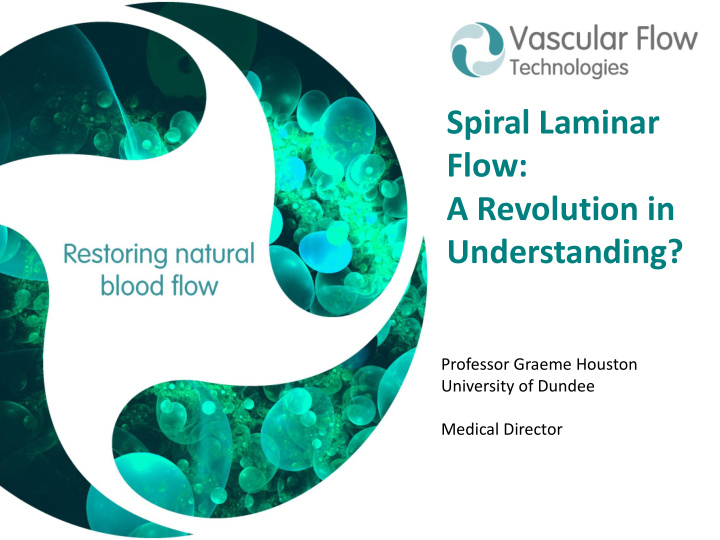



TRAINING Spiral Laminar Flow: A Revolution in Understanding? Professor Graeme Houston University of Dundee Medical Director
TRAINING Background: Spiral Laminar Flow in Arteries Spiral laminar flow (SLF) has been observed in healthy large and medium size arteries. SLF is believed to be created because: The heart is twisted on its axis. The aortic arch is curved, twisted and taped. SLF has been associated with: Maintenance of wall shear stress. Reduction of near wall turbulent kinetic energy. Enhanced end organ perfusion. Enhanced oxygen flux to the arterial wall. Protection against the development of atherosclerosis in native sections and implanted devices.
TRAINING Spiral Flow in vivo Cross section view of spiral flow in internal and external carotid arteries.
TRAINING Technology - Spiral Flow TM SLF TM Graft Healthy Artery Standard Graft
TRAINING Prosthetic graft patency: a product of a normal tissue response to a normal flow environment • Spiral laminar flow grafts produce normal flow patterns at the distal anastomosis • Endothelial cells are therefore in a normal flow environment • Flow mediated signals are not switched on and neointimal hyperplasia is lessened
TRAINING Turbulence = Graft failure Blood flow Non Spiral Spiral Spiral shows 30 times less “near wall turbulence”
TRAINING Cross-Sectional Colour Flow Images • Spiral flow and double spiral flow can be detected in the transverse plane using colour Doppler. Figure 4 : Diagram of spiral flow in the cross sectional [3]. Figure 3 : Diagram of spiral and double spiral flow in the cross sectional direction. 7
TRAINING Spiral Flow TM Grafts PV Grafts for peripheral vascular treatment. AV Grafts for arteriovenous connection. Figure 7: 8 mm ID (up) and 6 mm ID (down) PV spiral grafts. The helical ridge at the end of the grafts creates the rotational flow pattern. Sketch of AV spiral graft and image of its helical ridge from the front .
TRAINING Materials and Methods: Doppler Flow Experimental Setup • UHDC flow pump (Shelley Medicals). Constant flow applied for the presented results. • BMF: 707 Doppler testing fluid (ATS Laboratories). • VMM: 15% PVA-cryogel (PVA-c) (0.46% wt Benzalkonium Chloride). • TMM: 9% glycerol solution. • HDI 5000 (Philips ATL). Control Unit • Z.one plus (Zonare). Pump Unit Phantom Flow pump and phantom. 9
TRAINING Materials and Methods: Grafts – PVA-c connections Left: 8mm ID PV spiral graft connection with PVA-c arterial model. Right: 8 mm ID PV plain graft connection with PVA-c arterial model. Arterial flow Venous flow 10
TRAINING Materials and Methods: Arterial Phantoms Flow Direction Graft PVA-c artery Figure 14: 8mm ID PV spiral graft. Figure 15: 8mm ID PV plain graft. Arterial flow direction Graft PVA-c vein Venous flow direction Figure 17: 8mm ID AV plain graft. Figure 16: 6mm ID AV spiral graft.
TRAINING Results: 8mm PV Spiral Graft Spiral flow formation in the graft outflow. Scanning direction follows that of flow. Doppler parameters as in the video . Video 1: Spiral flow loop 5 cm downstream the graft outflow. Graft to PVA-c connection angle 35 ° , velocity approximately 30 cm/s. (Scanner used: HDI 5000)
TRAINING Results: 8mm PV Plain Graft Figure 19: Flow formation in the graft outflow. Scanning direction follows that of flow. Doppler parameters as in video . Figure 20: Longitudinal imaging. Video 2: Cine loop 5 cm downstream the graft outflow. Graft to PVA-c connection angle 35 ° , velocity 30 cm/s. This flow pattern has been found to imply double Doppler parameters as in video 2. helical flow in previous studies [6]. (Machine used: HDI 5000)
TRAINING Results: 6mm AV Spiral Graft Helical flow as it was detected in continuous frames 5 cm downstream the graft outflow. Flow velocity approximately 60 cm/s. PRF 3000 Hz, WF Max, Persistence Med, Gain 79% (HDI 5000 ). 14
TRAINING Results: 6mm AV Plain Graft Figure 22: AV plain graft out flow as it was detected in continuous frames 5 cm downstream the graft outflow. Flow velocity approximately 60 cm/s. PRF 3000 Hz, WF High, Persistence Med, Gain 79% (HDI 5000).
TRAINING Spiral Flow TM Grafts Phase 1 Study Spiral Flow™ Graft Participating centers • • Induction of spiral flow at Ghent University Hospital (B) F. distal anastomosis Vermassen, Chief Investigator • • 40 Patients Amphia Hospital Breda (NL) • • 8 centres in Benelux Antwerp Hospital (B) • • Study inclusion period Catharina Hospital Eindhoven (NL) 02/06 - 10/07 • Imelda Hospital Bonheiden (B) • Follow-up till 07/08 • Blasius Hospital Dendermonde (B) • 60% above knee, 40% • Medisch Spectrum Twente below knee • Zottgem • 57% CLI, 43% Claudication • 73 % male, 27% female
TRAINING Spiral Flow TM Grafts Study Results Spiral Flow™ Graft Patency 12 months 24 months Primary patency Above Knee 87% 81% Below knee 73% 57% Secondary patency Above knee 86% 81% Below knee 86% 64% NO amputations in series to date
TRAINING Progressive eccentric intimal hyperplasia with development of atherosclerosis in human arteries • All grafts and stents create turbulent flow • Turbulent flow damages endothelial cells leading to intimal hyperplasia • Intimal hyperplasia is the #1 cause of graft failure • Only Spiral Flow TM Grafts create normal flow
TRAINING Other Key Papers on Spiral Laminar Flow™ • “Three -dimensional Blood Flow Dynamics: Spiral/Helical Laminar Flow”, Peter A. Stonebridge, Ch.M. • “ Promising Results of a Spiral Flow Synthetic Vascular Graft: Theory and 2-Year Fem-Pop Results” Frank Vermassen, MD • “ Femoropopliteal Bypass with the Spiral Flow™ (SLF™) Graft: Early Results” Uður Çetingök, MD • “Hemodynamic effects of spiral ePTFE prosthesis compared with standard arteriovenous graft in a carotid to jugular vein porcine model” Ommid Kh. Jahrome • “Spiral laminar flow in the abdominal aorta: A predictor of renal impairment deterioration in patient’s with renal artery stenosis?” J. Graeme Houston
TRAINING Conclusion • SLF is the naturally occurring arterial blood flow pattern • SLF reduces turbulence • Standard Grafts destroy SLF • VFT PV and AV grafts maintain/reintroduce SLF • Clinical results PV at 24 months encouraging • Early results AV encouraging
Recommend
More recommend